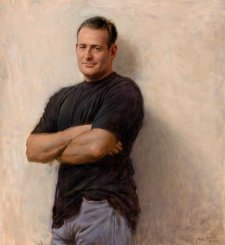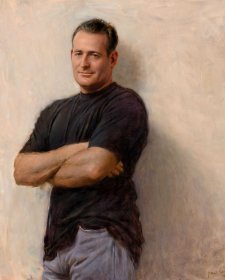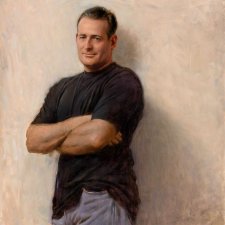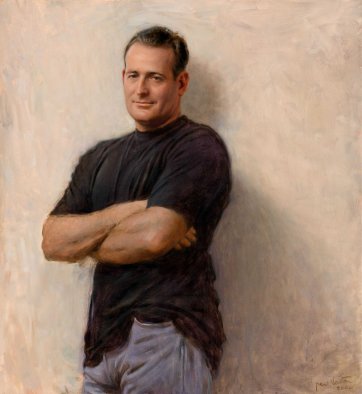The National Portrait Gallery would like to thank Paul Newton for his kind assistance with this project. All images courtesy of the artist.
Paul Newton: I initially had him posing with his arms folded, but when I got into the early stages of that painting I thought, “Well, maybe having the arms folded distances him from the viewer.” So I went a little bit cold on that composition, and I put the painting aside. I got another canvas, started again fresh, had him just put his hands in his pockets like this, which was a pose again that he adopted very naturally, and without having to be … and have it suggested to him. So I thought, “Well, that’s a good pose to work with.”
But during the latter stages of that painting, he was … David was in my studio when I was putting finishing touches on the painting, and this is when we were at Kenthurst and I had a rather large studio. And this painting was up in the back corner that I deliberately kept in the darkened corner, hoping that he wouldn’t notice it, nor the others who were there at the time. And he was having a … he was sniffing about, and he did notice it, and he said, “What’s happening with this, Paul? You haven’t finished this.” And I thought, “Oh, well, the game’s up.” And it’s interesting, because I really think that of the two variations it’s probably the more accurate, the more revealing of the two portraits, and says more about David Campese as a person. So I’m glad he suggested I finish it.
I see portraiture in a broader, more small “c” catholic sense, and I think it can encompass a whole range of possibilities. And really, the bottom line is some representation of a person where you’re hoping … attempting to reveal something about that person. It would be audacious to think that you could really capture or get to know them intimately. You can a little, but invariably they’re going to be putting on their … you know, a front as we all do when we’re in those sorts of situations. Which in a sense is why it’s often that a self portrait or a portrait of someone who’s very close to you may end up being the most revealing and authentic of portraits.
I think every portrait to some extent is … I don’t know who said this... was it Picasso or someone who said that every portrait is really a self-portrait? And I know when I’m doing my own painting, what I’m looking for is some resonance, some sense of the person looking back at me off the canvas.
Related information



Inspiration + Realisation: John Singer Sargent
Magazine article by Katherine Russell, 2006Katherine Russell examines the art of Australian artist Paul Newton, referencing the portraiture of John Singer Sargent.



The Gallery
Visit us, learn with us, support us or work with us! Here’s a range of information about planning your visit, our history and more!



Support your Portrait Gallery
We depend on your support to keep creating our programs, exhibitions, publications and building the amazing portrait collection!





